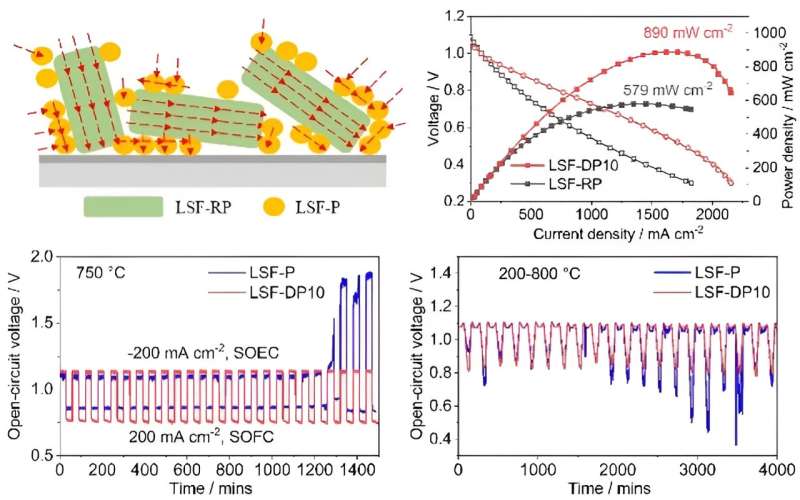This article has been reviewed according to Science X's editorial process and policies. Editors have highlighted the following attributes while ensuring the content's credibility:
fact-checked
proofread
Enhancing the performance, stability of solid oxide cells via in-situ forming of dual phase strontium lanthanum ferrate

Solid oxide fuel cell (SOFC) is a highly efficient and clean advanced energy conversion technology that converts chemical energy directly into electrical energy through electrochemical reactions and can be widely used for distributed and stationary power generation.
In the practical application process, it is necessary to consider the user's operational requirements and the maintenance demand. This may subject the device to conditions where temperature fluctuations are frequent and pronounced. For example, in residential applications, the SOFC system may undergo frequent cycles of activation and deactivation in accordance with the homeowner's requirements.
Furthermore, the temperature of SOFC may change during operation. For instance, when harnessing electricity from waste heat generated by industrial processes and thermal power plants, the SOFC may experience unstable heat supply. Additionally, substantial diurnal temperature variations in the SOFC's operational region or severe meteorological conditions, such as extreme winds and snowfall, can lead to significant temperature fluctuations.
The mismatch in the TEC of the different SOFC components can lead to the generation of thermal stresses during temperature fluctuations. These stresses may compromise the integrity of the interfaces between components, thereby degrading the SOFC's power output. Consequently, ensuring thermal cycle stability is a critical challenge that must be addressed to achieve the successful commercialization of SOFC technology.
Recently, a team of material scientists led by Liangzhu Zhu from Key Laboratory of Advanced Fuel Cells and Electrolyzers Technology of Zhejiang Province, Ningbo Institute of Materials Technology and Engineering, Chinese Academy of Sciences, China proposed the single perovskite oxide decorated R-P structured oxide could be synthesized by a self-assembly method, with the aim of enhancing the catalytic activity of R-P structured oxides while simultaneously preserving their stability. This work not only shows the excellent expansion matching between the strontium lanthanum ferrate and electrolyte, but also reveals its considerable potential as a competitive air electrode for SOFC.
The team published their work in the Journal of Advanced Ceramics on July 1, 2024.
"In this report, we synthesized dual-phase La0.8Sr1.2FeO4+δ and La0.4Sr0.6FeO3-δ by the simple self-assembly method. The single perovskite oxide, La0.4Sr0.6FeO3-δ (LSF-P), with cubic structure and high catalytic activity was introduced to facilitate charge transport across the R-P structured oxides La0.8Sr1.2FeO4+δ (LSF-RP) with various orientations.
"This approach overcomes the anisotropy inherent in the structure and concurrently enhances the catalytic activity of the composite electrode. The intimate hetero-interfaces that may form in situ between LSF-RP and LSF-P particles are anticipated to expedite the charge transfer process, thereby enhancing the ORR kinetics.
"We present the influence of the LSF-P content in dual phase on the phase structure, thermal expansion coefficient, electrode reaction kinetics, single cell performance under thermal cycling and reversible conditions in detail. The obtained results indicate that the incorporation of LSF-P improves the oxygen surface exchange kinetics, reduces the polarization resistance and significantly enhances the single-cell performance without sacrificing the stability of the composite electrode," said Liangzhu Zhu, professor at Ningbo Institute of Materials Technology and Engineering, Chinese Academy of Sciences, China.
"The TEC values of R-P oxides are comparable to those of the electrolytes commonly utilized in SOFC. However, it is important to note that R-P oxides exhibit two-dimensional conduction. They demonstrate significant anisotropy in the diffusion of oxygen ions and electrons, with transport predominantly occurring within the a-b plane and minimal movement along the c-axis. Consequently, there is a need to modify the R-P structured material to enhance its charge transfer capability, thereby increasing their catalytic activity, without sacrificing stability for application in SOFCs," said Liangzhu Zhu.
The most common strategy for increasing the catalytic activity of R-P oxides is introducing a secondary phase. "Mechanical mixing is a relatively straightforward method for the introduction of secondary phase. While mechanical mixing can enhance electrode performance to some degree, it struggles with achieving a homogeneous distribution of the phases, which in turn restricts the interfacial contact between them. Infiltration is another alternative for introducing the second phase material.
"However, it is a cumbersome and time-consuming process that requires multistep operations," said Yang Zhang, one of the co-first authors and a postdoctoral researcher at Ningbo Institute of Materials Technology and Engineering, Chinese Academy of Sciences, China.
"The self-assembly synthesis technique for fabricating composite materials is capable of yielding thermodynamically stable and homogeneously dispersed dual-phase structures in a single, streamlined operation. By merely adjusting the ratios of the starting materials, the incorporation of the second phase can be finely tuned.
"Furthermore, this self-assembly approach holds significant promise for creating numerous heterogeneous structural interfaces within composite air electrodes, which in turn can significantly boost the kinetics of the oxygen reduction reaction (ORR). Additionally, the method has the potential to greatly enhance the performance of composite air electrodes by optimizing the ORR process," said Liangzhu Zhu.
More information: Qihang Ren et al, An innovative and facile synthesis route of (La,Sr) 2FeO 4+ δ –La 0.4Sr 0.6FeO 3− δ composite as a highly stable air electrode for reversible solid oxide cell applications, Journal of Advanced Ceramics (2024). DOI: 10.26599/JAC.2024.9220938



















